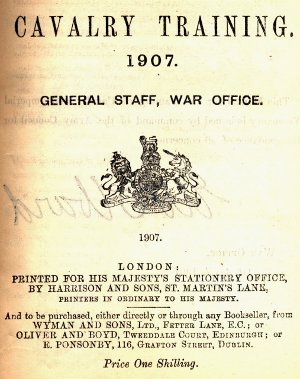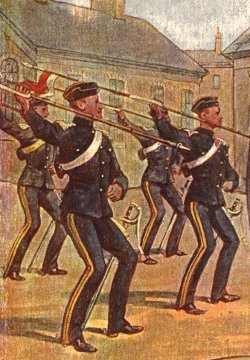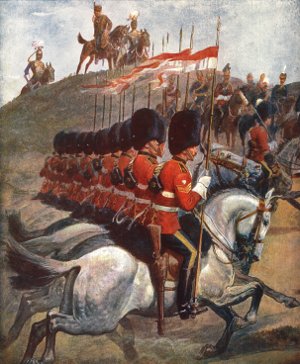Topic: Drill and Training
Cavalry Training (1907)
 S. 203. — Practical Instruction in the use of the Lance (Mounted).
S. 203. — Practical Instruction in the use of the Lance (Mounted).
1. To use the lance to the best advantage against an opponent in the charge, the mêlée, or in the pursuit, demands horsemanship, complete control of the weapon, skill and determination. The pace of the horse is also an important factor.
The Lancer should avoid engaging an adversary at a slow pace, which invariably results in both opponents circling round each other. The moral effect of the lance will thus be lost, and the greater reach of the lance over the sword will be of less advantage.
The aim of the Lancer should be to strike his opponent with the point and at speed. Against a horseman armed with a sword he will have the advantage of reach; against a dismounted man the advantage of both momentum and reach; and against a mounted Lancer he will not be at a disadvantage.
If he fails to get his point home when moving at speed, the pace will carry him for the moment out of reach of a counter attack. He can then either select another opponent or renew the attack on the original one. Apart from horsemanship, determination and skill in handling his weapon, his success must therefore be looked for in the suddenness of attack and pace, and in not permitting an adversary to force ehim into single combat.
For instructional purposes, fighting lance versus lance, or lance versus sword should, therefore, but rarely be ordered, and then only for giving the Lancer the necessary degree of practice in fighting at close quarters in situations into which he may unavoidably fall.
 For the latter purpose, the "thrust" may be practiced to the left and right fronts as follows:—
For the latter purpose, the "thrust" may be practiced to the left and right fronts as follows:—
"Right front thrust"
Raise the hand above the head and circle the point round by the left to the rear, arm extended to the rear; then deliver the thrust to the full extent of the arm and withdraw to the Engage.
"Left front thrust"
Circle the point round by the rear, bringing the butt direct to the left breast; then deliver the thrust to the full extent of the arm and withdraw to the Engage.
2. The aim of this practical instruction must be to teach the man:—
(a) To drive the point of the lance home with determination through an object which will offer sufficient resistance to resemble the human body.
(b) To retain a firm grip of his lance.
(c) To withdraw the lance with ease from the object into which it has been driven.
(d) To return the lance rapidly to a position of readiness so as to be prepared to deliver a fresh attack on either side.
(e) To ward off an attack with a parry or wave.
(f) To rapidly change his direction so as to deliver a fresh attack to either flank or to the rear.
3. Instruction on the following general lines will be found useful:—
Dummies representing men, both mounted and dismounted, should be set up in the open. These should not be arranged in any set sequence, but should be frequently moved, so as to ensure as much variety as possible from day to day.
 In the early exercises, one dummy for each run will suffice; at subsequent lessons two should be used, which should be in the same line, and on the same hand.
In the early exercises, one dummy for each run will suffice; at subsequent lessons two should be used, which should be in the same line, and on the same hand.
After which dummies may be set up on the same line of advance, but one on either hand. They should then be set up in conjuncture with jumps, which may be placed either before or behind them.
As individual skill develops, the dummies should be closer together, and in positions demanding rapid change of direction, but, they should never be so close as to render it impossible for the man to deliver his attack with effect before having to turn his attention to another one.
Men should be taught to deliver their points at the centre of the dummy which should therefore be marked for that purpose.
Practical instruction in pointing cannot be given unless the lances are sharp, and special care will be given to this.
The dummies should be arranged at heights to correspond to those of men both mounted and on foot.
Men should be taught to use the wave with effect by assigning one or more of the dummies or posts to be knocked over by this form of attack. Its use it to disconcert an opponent either by striking his horse over the head or by using it against him when unavoidably brought to close quarters and at slow pace will be explained, as also its usefulness in parrying a point and of sweeping the lance from an opponent's hand.
The best form of dummies for teaching the point are those made of wet clay, but when this form cannot be provided sacks filled with chopped hay or straw make fairly good substitutes. They should vary in size from that of a man's body to a head only.
Any suitable contrivance which will give a sufficient degree of resistance will suffice for practicing the wave and the parry.
Tent pegging should also form part of the instruction, but in this, as in the other practical instruction, a large number of runs must not be demanded from any horse in one day; three will usually suffice.
A sufficiency of instruction must therefore be obtained by practice during the intervals when other individual instruction is being given.
In order to prevent horses becoming excited and out of hand, they will all be walked quietly down the track at the end of the practice. If a horse shows any sign of becoming unsteady, he must only be walked down the runs for a few days.

